Hi, I’m Fred Dixon, CEO of Blindside Networks and co-founder of BigBlueButton.
Generative artifical intelligence is disrupting the normal processes of learning with significant negative consequences. I felt we lack a common framework to assess why this is happening and what to do about it. By shifting the discussion away from the technology to how our brains actually learn, I believe we can shift the focus from making learning “easier” to making it more efficient and effective, thereby ensuring positive outcomes for learners now and in the future.
Oreo Cookies for Everyone
Do you remember the first time you ate an Oreo cookie?
Maybe you were a kid, maybe you ate it with a cold glass of milk, and, if you can remember, your first thought was likely “Wow, I want another one!.” And you had another one. But what you may not have known was that the Oreo cookie was artificially designed to taste so good.
Oreo cookies, Pop-Tarts, Cheerios, and all their ilk are often called “hyperprocessed foods”. They are designed to make you want more, but are not natural, healthy, or good in large quantities. And what happens if you eat too many Oreos? The results are predictable: you will soon lose energy, gain weight, and feel tired. It’s short-term pleasure for long term displeasure. Food like this is hard to resist because your brain wants more. Lots more.
AI tools, such as ChatGPT, are like hyperprocessed foods for learning. That first time you use AI to solve an assignment question, it’s that wow feeling over again. That anticipated frustration from the twenty minute struggle to do the question? It’s gone in about two minutes of prompting. If you are looking at five more assignment questions to complete, and that frustration will go away with five more prompts, your brain wants to use it again. What happens if we use too much AI to make learning easier?
Here, too, the results are predictable.
But AI Tastes so Good for Learning
In a 2024 study, the Wharton School did an experiment to see the results of using AI to assist learning. They took a set of 1,000 high school students preparing for a math exam and divided them into two groups. The first, Group A, were given generative AI tools, such as ChatGPT, to help them prepare for the exam. The second, Group B, were not given access to such tools. The results? Group A performed worse on subsequent tests than Group B. The researchers concluded that “while AI can assist in learning, overreliance may hinder the development of critical problem-solving skills necessary for independent test-taking” (Bastani et al., 2024).
After reading that study, I became curious if the results would have turned out differently if Group A had been properly educated on how to use AI effectively.
To answer this question, let’s imagine you were going to the local gym to work out. You’ve committed one hour of your time. After entering the gym, you stood for 60 minutes, stared at the weights, and then left. We would all agree that not much is going to change in your muscles or overall health.
Now, imagine a different workout in which you put your muscles under just the right level of stress, for just the right length of time, using just the right exercises. You also ate well, rested, and repeated the workout, each time varying the exercises so your muscles don’t get used to the repetition. After a few short weeks, you’ll be stronger. Guaranteed. Now layer in a deep understanding of how your muscles actually work, and a personalized workout plan optimized for your level of skill and fitness. The next time you visit the gym, you may need only 40 minutes, but you are going to sweat a bit more.
While the brain is not a muscle – in fact it is much more complicated than a muscle – there are some similarities: in a mental workout, you might work on a problem at just the right level of difficulty, for just the right level of time, and then eat well, rest, review the problem, and repeat as necessary, each time varying the tasks so your brain has to think harder. After a few weeks, you’ll master the skill. Guaranteed.
But why?
System 1 Thinking vs. System 2 Thinking
While the brain is more complex than a muscle, is there a simple way to understand how learning works? In his 2011 book Thinking, Fast and Slow, Nobel Prize laureate Daniel Kahneman offers an illustrative metaphor that captures much of this complexity (Kahneman, 2011). He proposes that our brains operate using two modes of thinking: one fast and intuitive, and the other slow and deliberate. He refers to these as System 1 and System 2.
You can think of System 1 as instinctive, intuitive, and able to draw upon the brain’s storage of connected knowledge. System 1 can also respond very quickly. Try this: ask yourself what is 3 * 7?
If you have internalized the basic multiplication tables, your brain gives the answer almost instantly: 21.
You can think of System 2 as “think twice before answering”. For example, ask yourself what is 34 * 47? (Try for 20 seconds to answer, no pens, no calculators, no AI).
Notice that something happened in your brain. Something shifted to a different mode of thinking. That’s System 2, and it is more deliberate, thoughtful, and able to combine together existing connected knowledge with new concepts.
System 2 is where the real learning occurs. For everything you’ve learned – for every class that you’ve taken, for every skill you’ve mastered, for every entry in the multiplication table you’ve memorized – System 2 first had to wrestle with it, figure it out, and eventually store it into your hierarchy of knowledge.
It moved this knowledge or skill from an unknown to a known state. Of course, there is a gap between those two states. Here’s what it looks like.
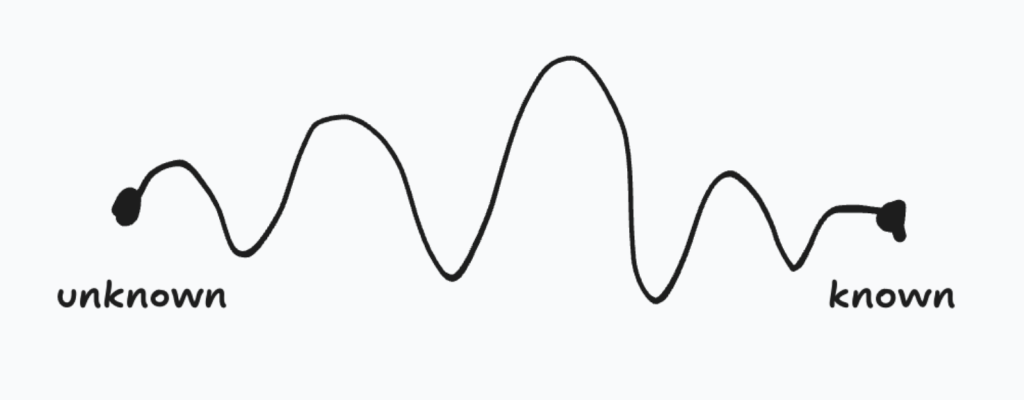
I love this diagram. It implies that learning is not linear (it never is), that learning has highs and lows, and learning – real deep learning that activates System 2 – takes time. If you could pick one word that best describes the feeling between the unknown and known state, what would it be? (Hint: we’ve already used it multiple times above).
I believe that word would be frustration.
No Frustration, No Learning
System 2 is lazy. Our brains use 20% of our body’s energy and, like our muscles, our brain is designed to conserve energy. System 2 doesn’t want to wake up; it would rather let System 1 do all the work.
Back in the gym, if you’re pushing your muscles in a good workout, at some point you’ll start to feel a burning sensation. To some, this feeling is akin to a light pain, leading to the maxim “no pain, no gain.”
But this sensation plays a very important role: it tells you that your muscles are taxed beyond their normal level, that they have “woken up”, and that the real workout has begun. Keep pushing, rest and recover, you’ll reap the benefits and come back stronger.
When learning something new, when System 2 has woken up, the sense of frustration plays a similar role. It’s telling you the real learning has begun. The equivalent maxim for learning should be “no frustration, no learning.”
Another challenge is that System 2 has limited working memory. You may have heard that most people can remember around seven items at once—but when this limit is exceeded, cognitive overload occurs (Sweller, 1988). In the gym, it’s akin to trying to lift a weight that’s too heavy to move.
In a 2001 study, Nelson Cowan suggested that for activities where the brain cannot effectively do chunking, such as when learning a new skill, the actual number of items we can hold in working memory is around four (Cowan, 2001).
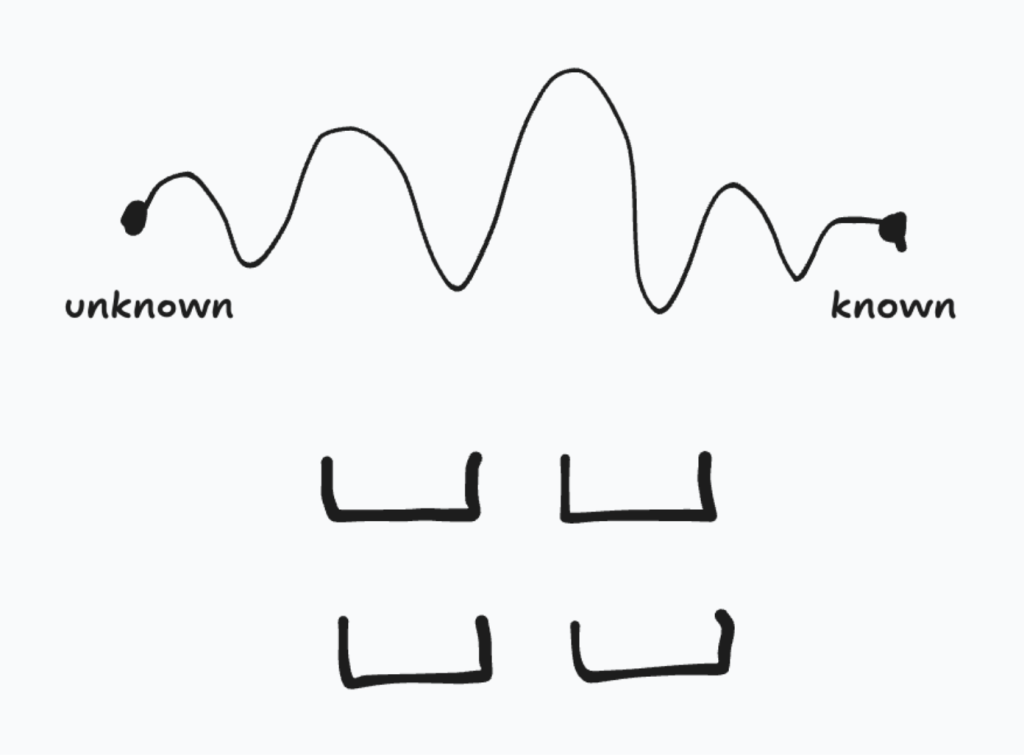
Four may not seem like much, but the good news is that System 2 can lean heavily on the intuitiveness and efficiency of System 1 to retrieve base knowledge. For example, if System 2 can lean on System 1 to calculate (or retrieve) the result for 3 * 7, then more working memory is available.
Working memory is important as it must try to hold on to tenuous ideas or concepts. In pedagogical terms, this tenuous knowledge that takes up precious working memory is called scaffolding.
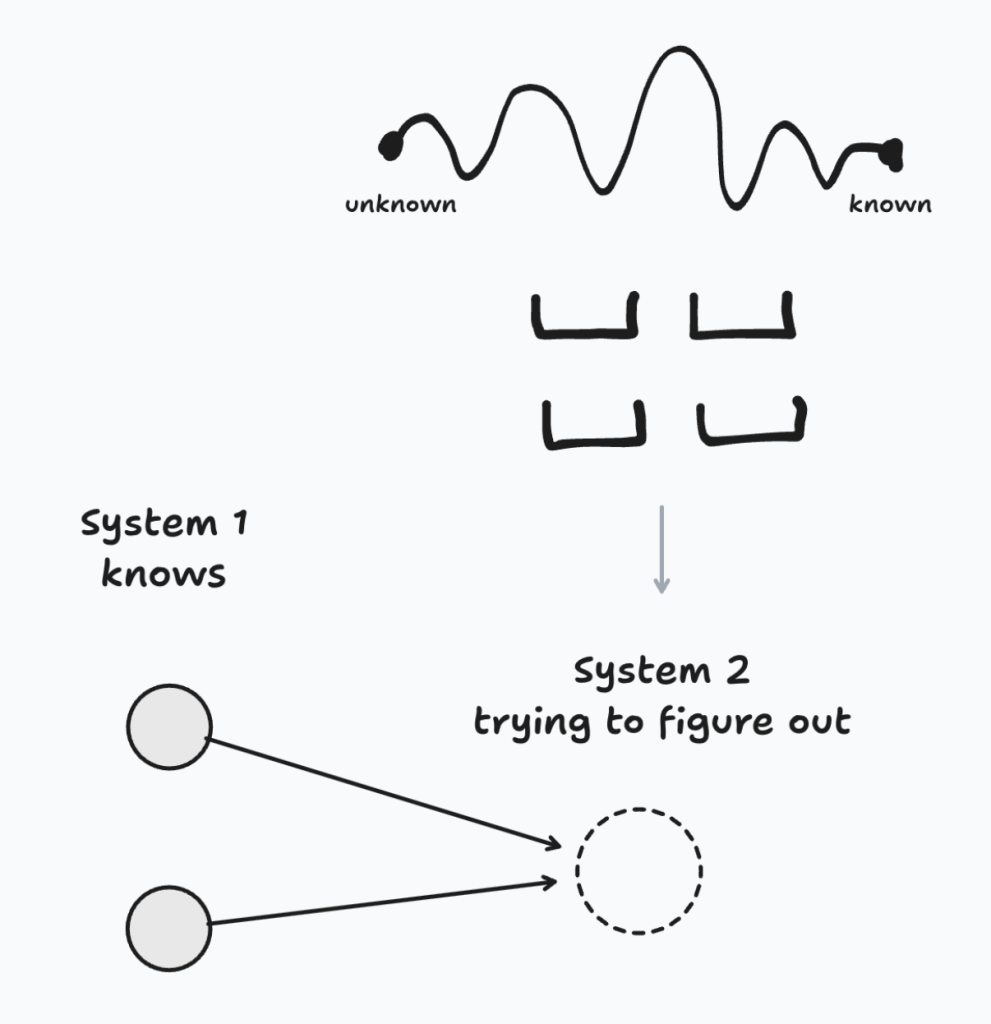
The point of this highly simplified picture is to illustrate that when you construct new knowledge, the new knowledge is itself tenuous. In pedagogical terms, we call this effort Constructivism. The feeling of frustration is the feeling of your brain figuring out how to construct the new knowledge and fit it into the existing hierarchy. As you construct new knowledge, at some point your brain “clicks” and it makes sense, and the new knowledge moves into the existing hierarchy. This is also known as “learn it, link it”.
At this point you may be thinking great, all I need to do is study, be frustrated, and eventually I’ll learn.
Actually, you can be far more effective.
Effective Learning is Not What You Think It Is
System 2 is lazy, and it is very good at staying lazy.
To see how, here are some common approaches to learning. Given the question below on effective learning techniques, what do you think is the correct answer?
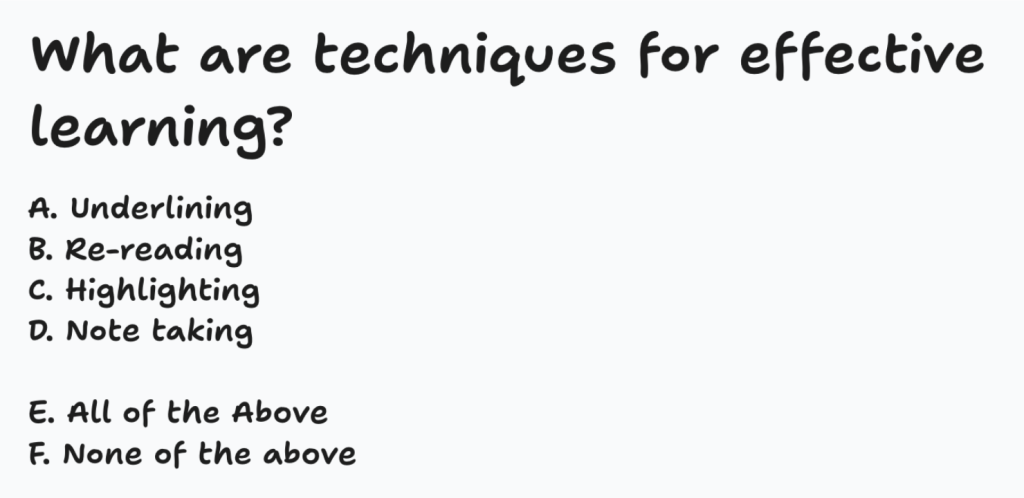
If you answered A, B, C, or D, you are incorrect (years of research have shown this to be so). Given that none of them are correct, E is certainly wrong. The correct answer is F.
Wait a minute!? You may be thinking “I’ve spent hours (or years) carefully highlighting study notes, underline the key phrases, and re-read over and over, and re-watched the YouTub videos, and they are not effective studying techniques?!”
Turns out, your brain is tricking you. The problem is all of the above techniques are largely using System 1 thinking which, if you repeat doing it enough, creates familiarity, but not mastery. When using these techniques, System 2 stays asleep.
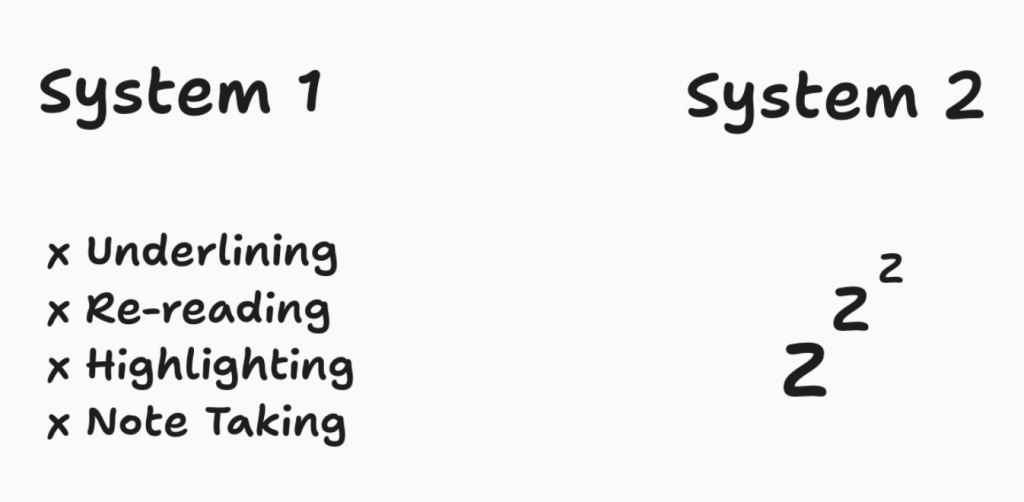
This explains what happened in the Wharton School’s study. Group A very likely used AI to get the answers, System 1 looked at the worked answer and said “yes, that’s the right answer”, and moved on. But without System 2’s involvement, there was no real change in the brain. Group A ate a lot of Oreo cookies.
Thirty years ago, when I was taking a second year math class at University of Waterloo, my professor once told the class “The best way to learn is to close the textbook and try doing the problem yourself.”
He was so right. If you just read something in a book, or screen, then look away and try to apply it, suddenly everything is much harder. That sense of frustration occurs because System 2 has woken up and it’s trying to figure it out. The real learning has begun.
The question is how to use System 2 effectively?
What is Effective Learning?
In the excellent book Make it Stick (Brown, Roediger, & McDaniel, 2014), the authors summarize ten years of research into effective learning into three main techniques:
- Get knowledge out
- Desirable difficulty with interleaving
- Spaced repetition
Getting knowledge out means focusing the effort on retrieving knowledge, not storing it (the retrieving part actually juices the storage effect). It may be closing the book or using flash cards.
Desired difficulty means working on problems at the level of our skill, and mixing up the problems so our brains are constantly adjusting and learning. Spaced repetition means giving the brain repeated attempts at (1) and (2), thus re-encoding the knowledge and its links into our existing knowledge hierarchy until it becomes readily available to System 1. At that point, you have mastered the skill to retrieve and apply it with System 1, freeing up more working memory in System 2 for the next concept.
For fun, let’s push the gym analogy a bit further. If we tried applying these principles to the gym workout, here’s how they look.
Effective techniques |
The physical workout |
| Get knowledge out | Actually lift the weights, causing the muscles to “wake up”. After a bit, we feel the burn. |
| Desired difficulty with interleaving | Use weights that match our strength (not too light, not too heavy). Mix the exercises so the muscles constantly have to adjust and accelerate their growth. |
| Spaced Repetition | Have a good rest, avoid processed foods, and repeat (1) and (2). |
Let’s apply this to our brain. Welcome to your new “learning workout” routine.
Effective techniques |
The learning workout |
| Get knowledge out | Lift the knowledge out of your brain, not the page (i.e. close the book or use a flash card). System 2 wakes up and the effort of recall strengthens the encoding for System 1. |
| Desired Difficulty | Practice solving problems at the upper edge of your cognitive ability. Mix the problems so System 2 has to work even harder, deepening your understanding and strengthening the encoding. |
| Spaced Repetition | Have a good rest, giving the brain a chance to move the newly acquired knowledge or skills into System 1, then repeat (1) and (2). |
If the above is effective learning, then how efficiently can you learn? In other words, how can you achieve optimal learning taking more effort but less time?
In the 1930s, Lev Vygotsky introduced the concept of the Zone of Proximal Development, or ZPD for short (Vygotsky, 1978). Personally, I like to think of ZPD as “getting into the zone,” which I divide into three parts: too easy, in the zone, and too hard.

Let’s relate this to System 1 and System 2 thinking.

According to the ZPD, at the lower end of the zone, learners are capable of understanding and progressing independently.
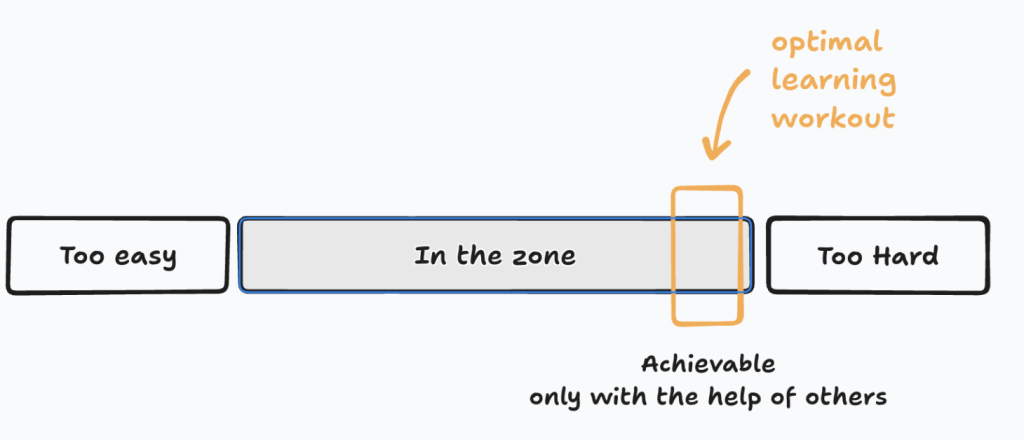
ZPD’s key insight is that you can only reach the upper end of the zone, or the optional learning workout, with the help of others.
This portion of learning is only achievable through guidance, collaboration, or scaffolding provided by more knowledgeable individuals.
That too makes sense. If you go to the gym with friends, or with a personal trainer, the workouts are going to be more efficient (and more enjoyable). The trainer can watch you, see where you are struggling, and, when needed, put a light touch under the weight to help those last few reps. They can also vary your exercises to prevent your muscles from getting too used to the workout.
Building Up Your Stamina for Frustration
A short aside, and I’ll just say this outright: social media has weakened our ability to endure frustration.
When you start really applying yourself, you’ll find your stamina for enduring frustration has atrophied a bit.
But if you stick to the mental workout plan, you’ll get stronger.
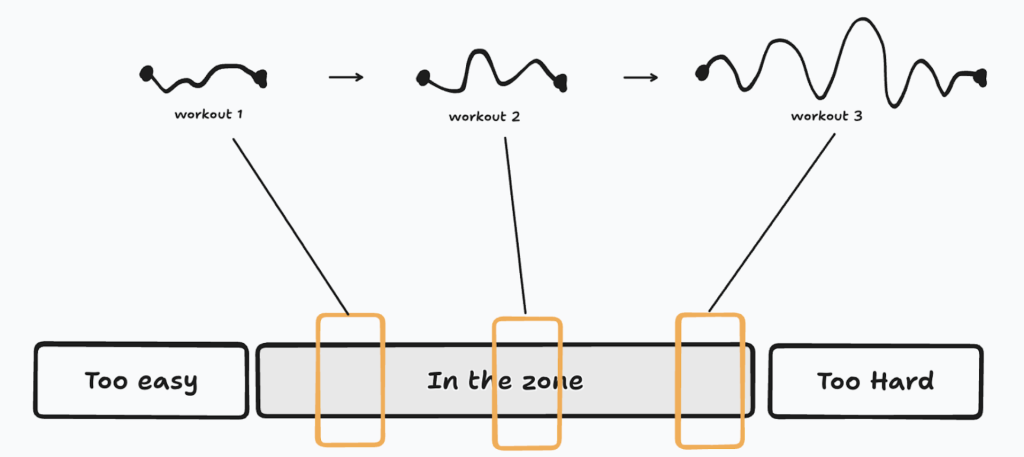
So where do you find a community of learners with a personal trainer ready to help optimize your learning?
It’s in the classroom.
Enter the Classroom (Physical or Virtual)
If learning by yourself is like individual cognitive workouts, then learning in the classroom is like team practice with a coach.
Learning anything significant is going to take structured workouts and a buildup of new hierarchical knowledge. Educators, like coaches, have already figured out the underlying concepts of such topics and can chart the most efficient order of learning them.
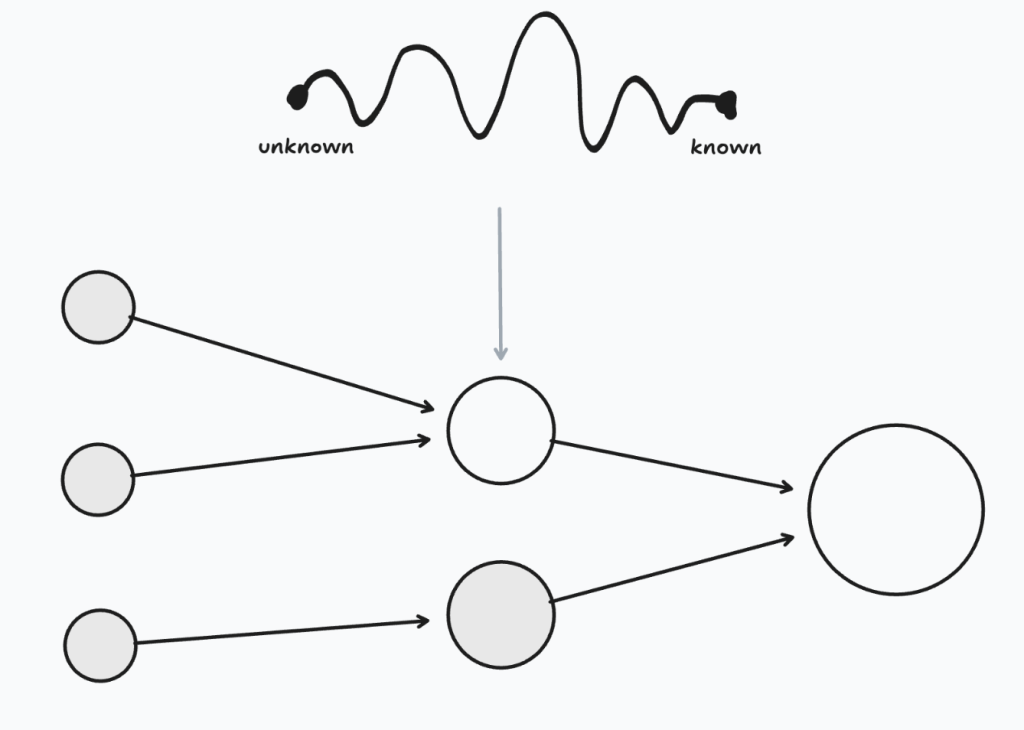
Learning together also has a pedagogical name: it’s called Social Constructivism – we construct knowledge with and for others.
The reason Social Constructivism is so effective is when we have discussions in the class, or join breakout rooms, System 2 is in overdrive. When teaching a topic to another, System 2 has to communicate at the level of the recipient, understanding their gaps and pitching the concepts at just the right level to absorb. Doing so strengthens your own understanding. It extends the “learn it, link it” process to “learn it, link it, teach it”.
As an aside, if you think you don’t need a real classroom to learn something significant, you may be right, but you would be in the minority. In 2010 there was a big movement towards offering massive open online classes (MOOCs) where everyone could take world-class lectures by themselves. In a recent review of MOOCS, the results showed that only 12% of students actually completed the course (Jordan, 2015). And who were most likely to complete? It was the ones who already had an undergraduate degree. In other words, they had built up the System 2 muscles. They were already learning athletes.
If you happened to teach or attend online classes during Covid, you likely had a very poor experience. The following table explains why.
Using a video conferencing system … |
Using a virtual classroom … |
|
| For the educator | Students were invisible, leading to largely “teaching to the screen”. | Engage students using built-in tools for active learning and live analytics to ensure every student learns. |
| For the learner | Passive learning using System 1. | Active learning using System 2 and staying in the zone. |
The educator could use AI to help structure the class, but, as a learner, you don’t want to use AI during the class since it will let System 2 drop out of the zone, reducing the benefits of your participation in the class.
Instead, you want to take advantage of the classroom in order to increase your interaction with others and the teacher. The more feedback you get, the faster you learn. And my personal belief is that humans learn best from humans.
If you shouldn’t use AI during the live class, then when can AI help?
The Effective Role of AI in Learning: Before and After
Recall the Wharton study and the underperformance of students in Group A. Based on the preceding sections, they most likely used ChatGPT to make the learning “easier,” and thereby bypassed the real learning that occurs in System 2. In other words, they ate a lot of Oreos.
Let’s revisit the gym. Imagine you paid for a personal trainer, and at the start of the workout, the personal trainer walks in, looks at your workout plan, then proceeds to do every exercise for you, then walks out. At this point, you’d probably think “Hey, you just did the workout, how are my muscles going to grow?”
Effective learning means an effective learning workout with System 2. But there are three barriers to having such a workout.
- Your brain doesn’t know what it doesn’t know
- System 2 is lazy
- It feels frustrating to learn
My sister runs marathons. Years ago, she showed me an app where she puts in her age, level of fitness, and the distance for an upcoming race. The app then worked backward and told her the training routine to follow. Basically, she said, “Look Fred, if I follow the workout plan, I’ll be able to run the marathon”.
Does such an app exist for learning, one that could personalize your learning workout?
Yes, it’s called ChatGPT.
Armed with the knowledge in the previous sections of how to learn efficiently, take a subject you want to learn, something of significance, and use a prompt like the following.
I am trying to learn how <DESCRIBE WHAT YOU ARE TRYING TO LEARN>, represented below as {new concept}. I am a <beginner, intermediate, or expert> represented below as {my level}.
You are my personal tutor. First, create ten questions that will probe my understanding of the foundational knowledge needed to do {new concept} at {my level} of knowledge. Wait until I reply to these questions, then, based on my answer, ask me ten questions that probe my ability to do {new concept}. Each question should take no more than 2 minutes each.
Once I’ve given you the answers to both sets of questions, come back with a study plan with an optimal sequence of activities on what I need to learn to achieve {new concept}. Each activity should be difficult enough to shore up my difficulty.
I’ve created an expanded version of this prompt that gives more explicit instructions ChatGPT, or any other generative AI model you want to try out.
This prompt turns ChatGPT into your personal tutor, causing it to create a personalized learning workout based on your knowledge and skill level.
In the prompt, you can vary the number of questions (choose a smaller number than 10) and the length of time to respond to each question (choose a smaller duration than 2 minutes). If you’re a student that needs special accommodations, you can modify the prompt to tailor the study plan to your accommodations.
Using this prompt and answering the subsequent questions will definitely activate System 2, so be ready. Your brain will say “Wait! I don’t know most of this!”. That’s the point.
The reward for your 20 minutes of frustration is an optimal plan to learn the subject as efficiently as possible. Doing this will put you in control of your learning and address the first two points above.
What about the 3rd point: that it feels frustrating to learn? I believe we can do better there as well.
Is There Another Mode Besides Frustration?
Because learning is frustrating, most of us delay it as much as possible. In the past, you may have taken a course, put in the minimum amount of work so as to avoid frustration, and then crammed just before the exam. Relax. You’re human. We’ve all done this.
Frustration is not a pleasant feeling. I believe there are approaches to learning that overcome the frustration. You’re still going to feel frustrated, but these reframe the feeling into something of your choice.
First, there is a better way to begin learning: curiosity.
Before starting to learn, think like you were younger and ask why, why, why. “Why does this happen?”, or “Why does that happen?”. Asking these questions primes System 2 to wake up and provide answers. Note, it won’t always be able to give correct answers, but as you learn if you did, there is a feeling of satisfaction. And if your answer was incorrect, the curiosity deepens to figure out where your answer was wrong.
Second, at some point, when curiously shifts back into frustration, that’s when you shift again to the next mindset: the hunter.
As humans, we are genetically programmed to hunt and fish (honestly, you wouldn’t be here now if our ancestors didn’t have this genetically encoded). Personally, when I’m dialed into solving a problem, I’m so focused on hunting that my progress turns into clues. I can sense my prey getting closer, and I start to draw on all my skills and knowledge to stay in the hunt.
Third, as you become a better hunter – you’ve built up your stamina as described in the previous section – you naturally enter a third state of learning: flow.
This is the most enjoyable state. This is when you have enough base knowledge, your problem solving skills are sophisticated enough, and, as you get closer to the answer, time disappears. You are lost in the hunt and, when everything finally clicks, the sense of satisfaction is profound.
(I encountered all of these modes while writing this article. At the beginning, after reading about various learning theories and concepts, I was curious if they could be threaded together. I then hunted for a narrative that would connect in a manner that satisfied me. That took a few drafts and some pretty intense frustration, but I could smell my prey. Then, once I had the connections and the diagrams figured out, I felt myself slip into a state of flow where the article almost wrote itself.
Learning is Different From Work
One last quick point before wrapping up—if you’re an adult learner, chances are you have a job. So, how is using AI for learning different from using it at your job?
At work, AI multiples the skills you already have. You can use AI as a personal assistant to free up time by doing routine tasks, as a peer to help you apply your skills, and as an editor to sharpen them. Overall, it makes you faster and more effective.
In other words: you can hunt bigger game.
Conclusion
Many of us have used ineffective study techniques that resulted in ineffective learning.
Based on recent knowledge from Make it Stick, understanding the brain’s modes of System 1 and System 2, and learning effectively with others to get into the zone, we can make better choices that substantially improve the efficiency and effectiveness of our learning.
We are all different. Sometimes the challenge is not knowing what you don’t know. Using AI as a personal tutor to create a personal study plan keeps System 2 in the zone. Your study time will shorten, the study sessions will be more intense (think sweating more in a gym workout), and you’ll get much better results.
But beware anytime you hear a claim that some new AI product makes learning easier. If you’re serious about learning, you want more intense mental workouts for System 2, not letting it revert back to System 1 for ineffective “easier learning”.
As you focus on using System 2 – where the real learning occurs – your stamina for enduring frustration will extend (remember: it’s how your brain tells you it’s learning). As you keep focused, the feeling of frustration gives way to curiosity, then to the mindset of the hunter, and then to the state of flow.
And yes, once in a while, it’s OK to have an oreo cookie when learning. It tastes better with cold milk.
Fred Dixon is the CEO of Blindside Networks, the company that started BigBlueButton, a virtual classroom that focuses on providing educators built-in tools for active learning and live analytics to ensure every student learns. Fred has been using computers for over forty years and deeply believes that humans learn best from humans.
This post was partially inspired by a presentation titled Veritasium: What Everyone Gets Wrong About AI and Learning – Derek Muller Explains given at Perimeter Institute for Theoretical Physics in 2025 (Perimeter Institute, 2025).
References
Bastani, Hamsa and Bastani, Osbert and Sungu, Alp and Ge, Haosen and Kabakcı, Özge and Mariman, Rei (July 15, 2024), Generative AI Can Harm Learning. The Wharton School Research Paper, Available at SSRN: https://ssrn.com/abstract=4895486 or http://dx.doi.org/10.2139/ssrn.4895486
Brown, P. C., Roediger, H. L., & McDaniel, M. A. (2014). Make it stick: The science of successful learning. Belknap Press.
Cowan, N. (2001). The magical number 4 in short-term memory: A reconsideration of mental storage capacity. Behavioral and Brain Sciences, 24(1), 87-114.
Jordan, K. (2015). Massive open online course completion rates revisited: Assessment, length and attrition. The International Review of Research in Open and Distributed Learning, 16(3). https://doi.org/10.19173/irrodl.v16i3.2112
Kahneman, D. (2011). Thinking, fast and slow. Farrar, Straus and Giroux.
Miller, G. A. (1956). The magical number seven, plus or minus two: Some limits on our capacity for processing information. Psychological Review, 63(2), 81-97.
Perimeter Institute (2025). Veritasium: What Everyone Gets Wrong About AI and Learning – Derek Muller Explains [Video]. YouTube. Available at: https://www.youtube.com/watch?v=0xS68sl2D70
Sweller, J. (1988). Cognitive load during problem solving: Effects on learning. Cognitive Science, 12(2), 257-285.
Vygotsky, L. S. (1978). Mind in society: The development of higher psychological processes. Harvard University Press.
Veritasium (2017). The Science of Thinking [Video]. YouTube. Available at: https://www.youtube.com/watch?v=UBVV8pch1dM